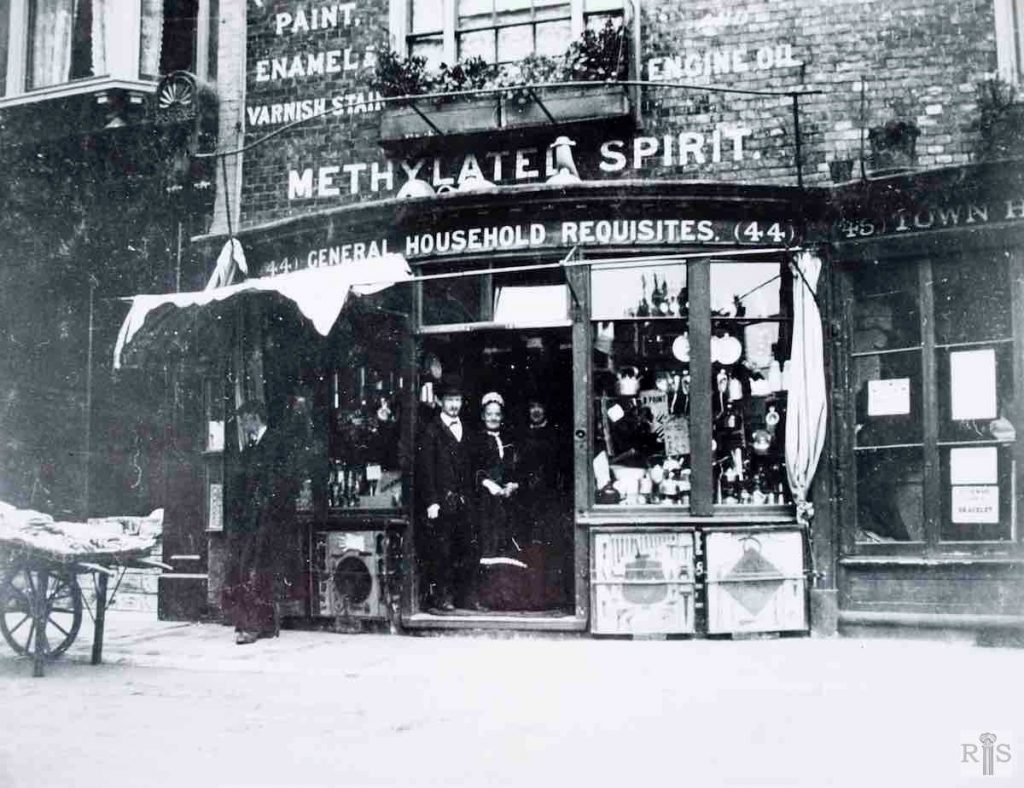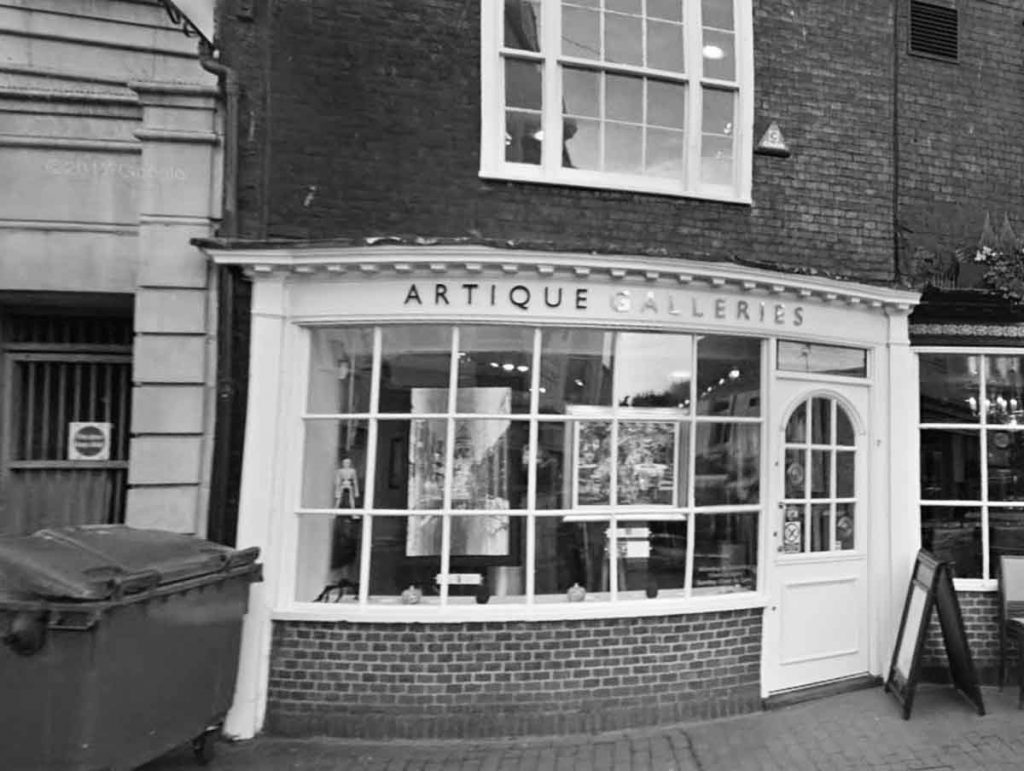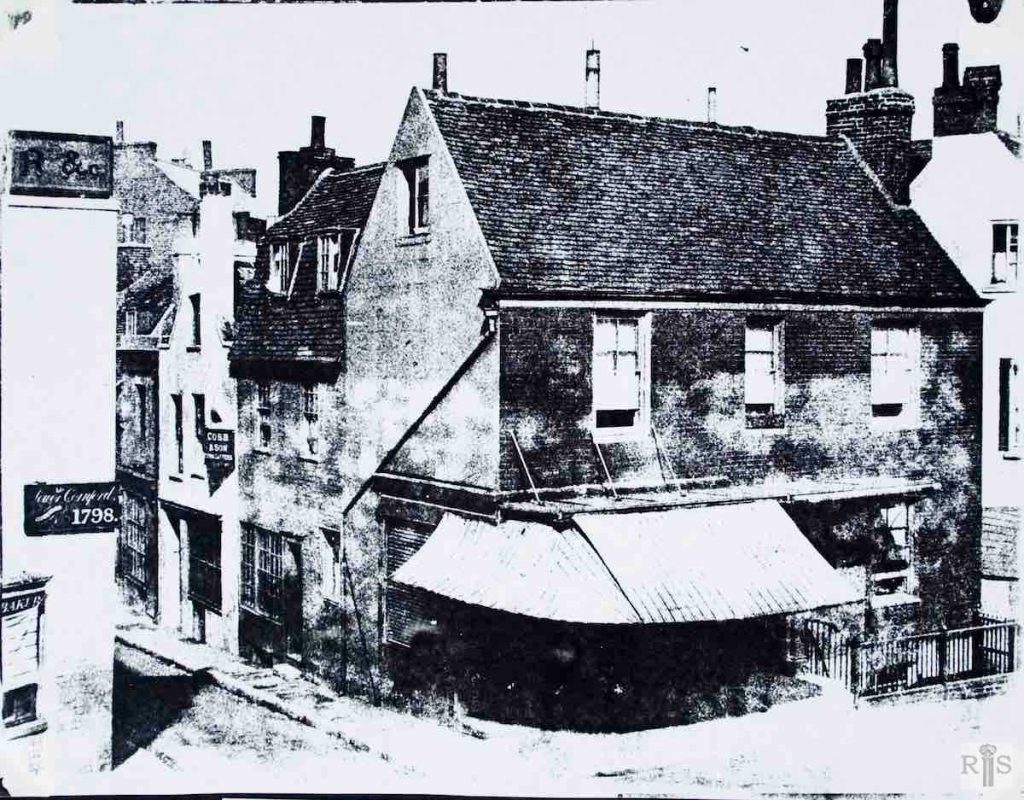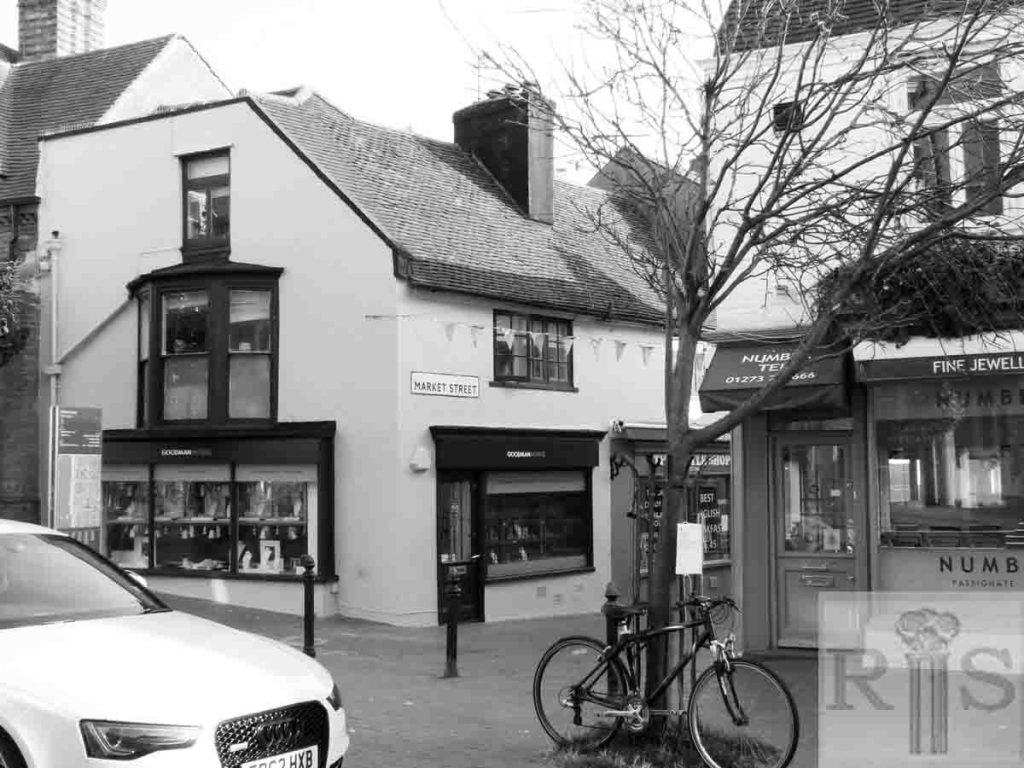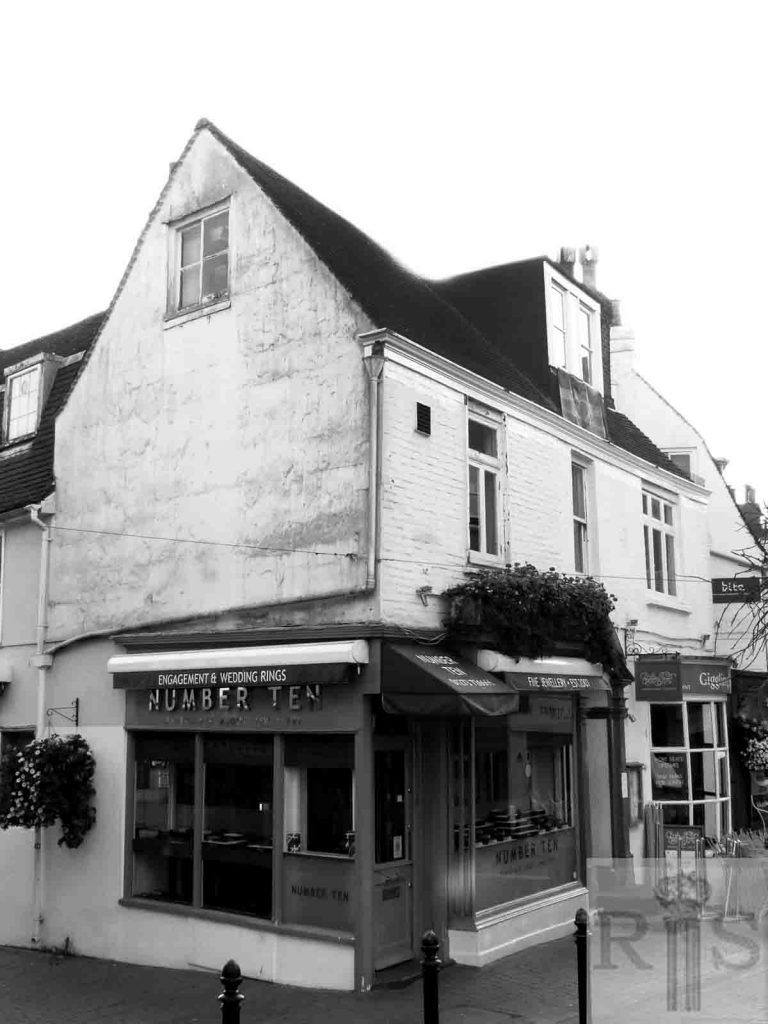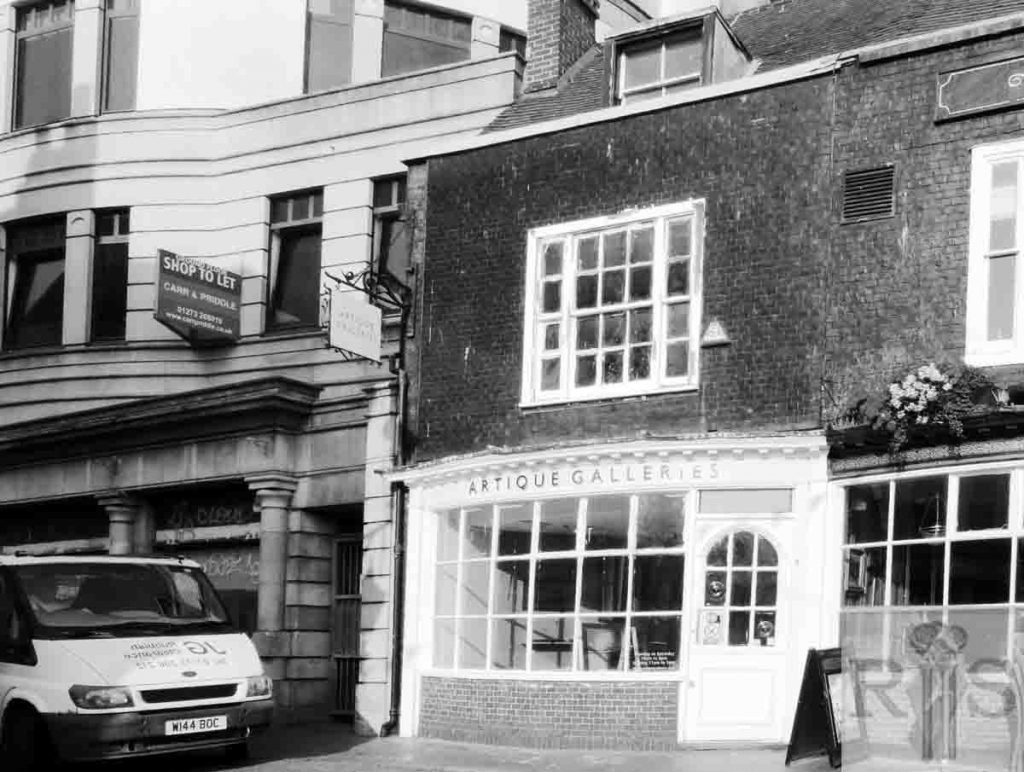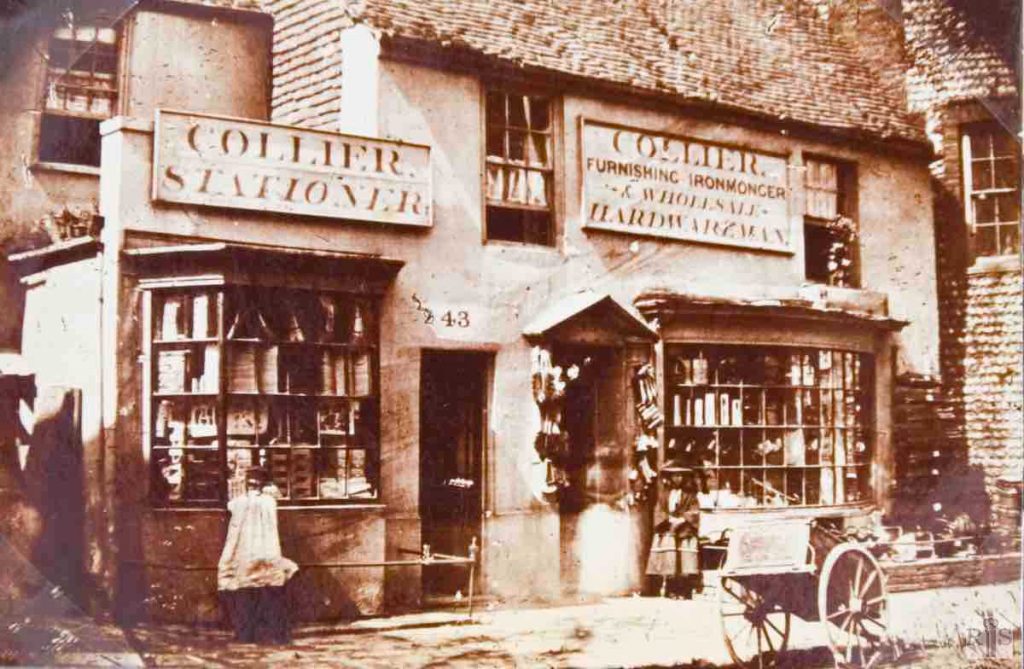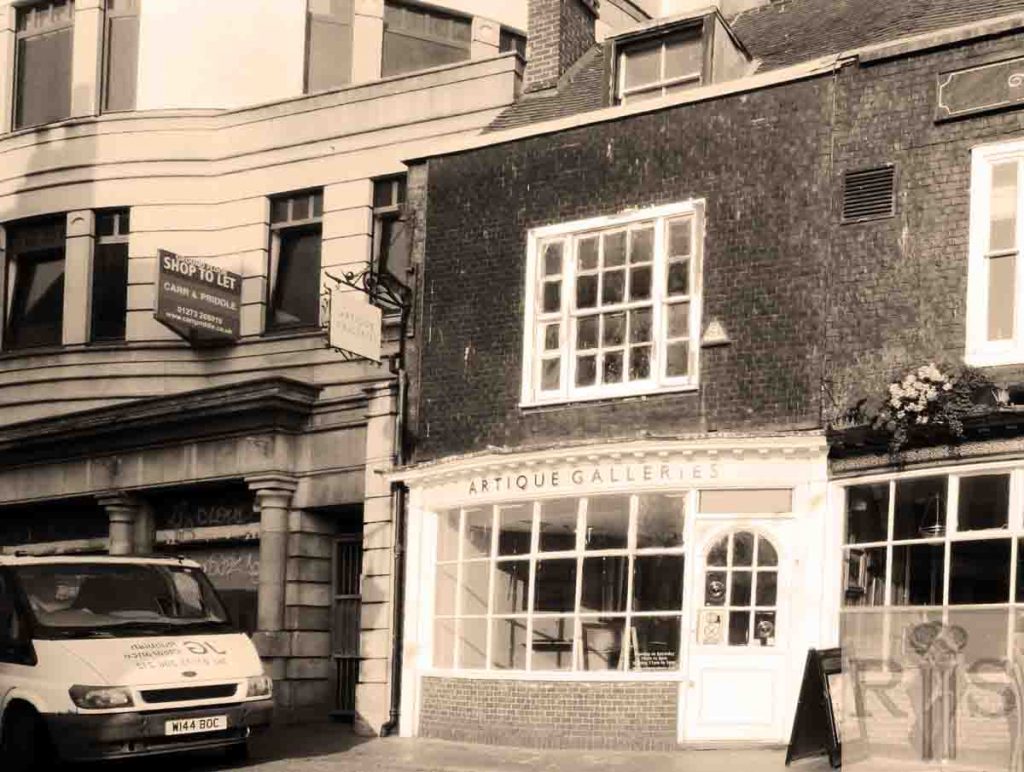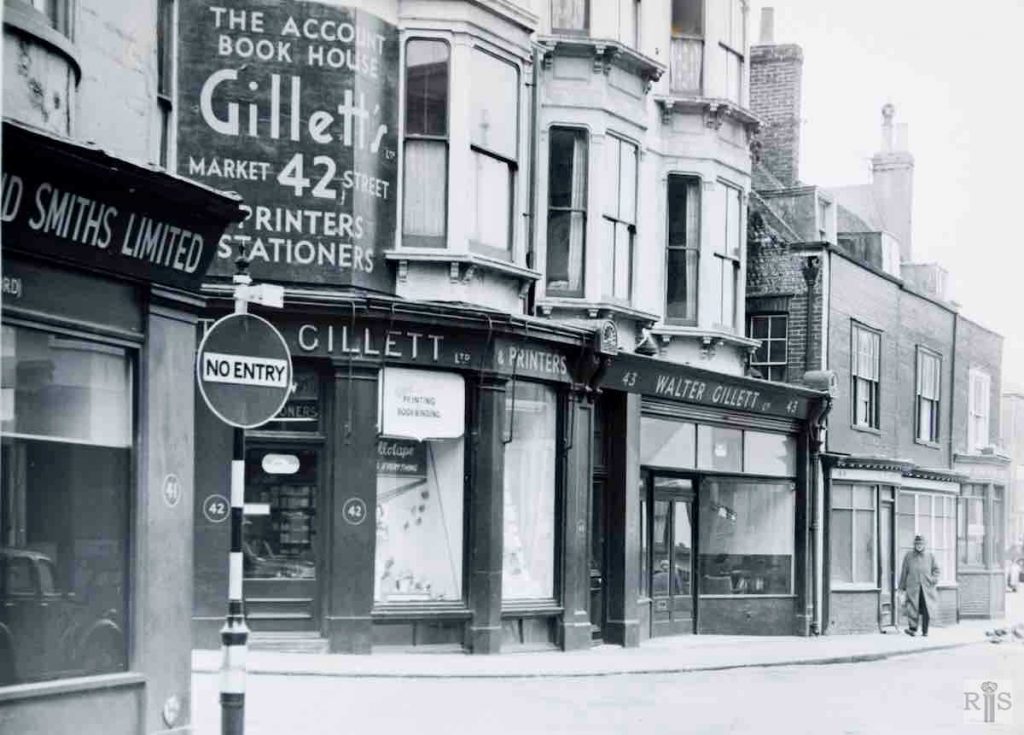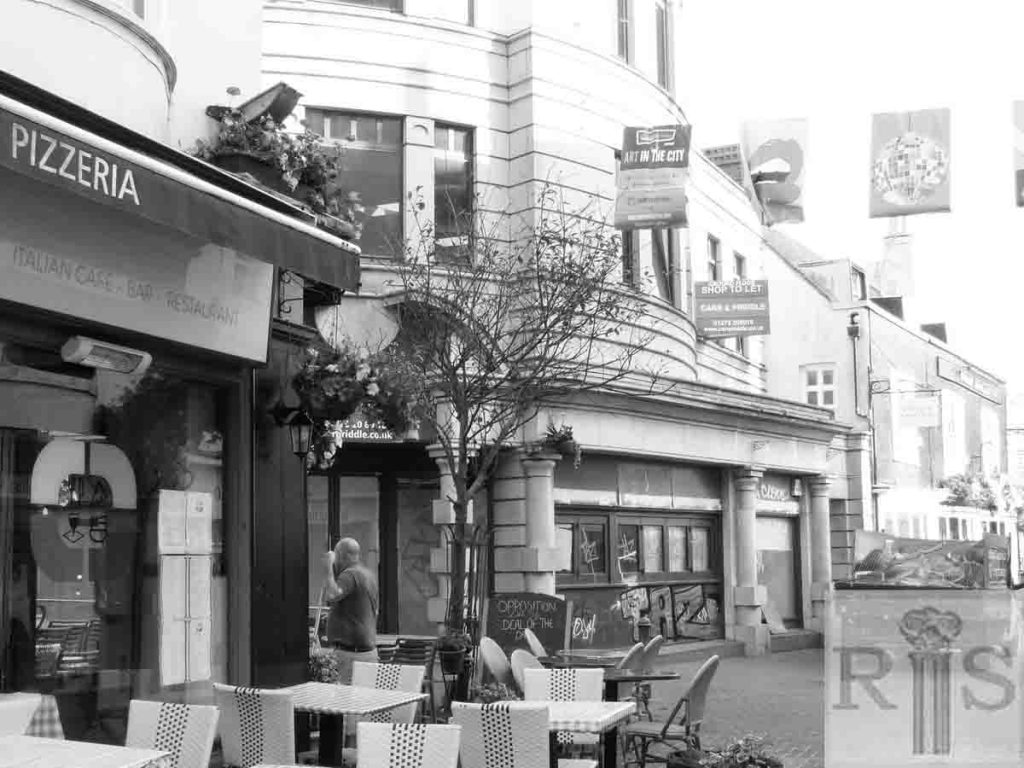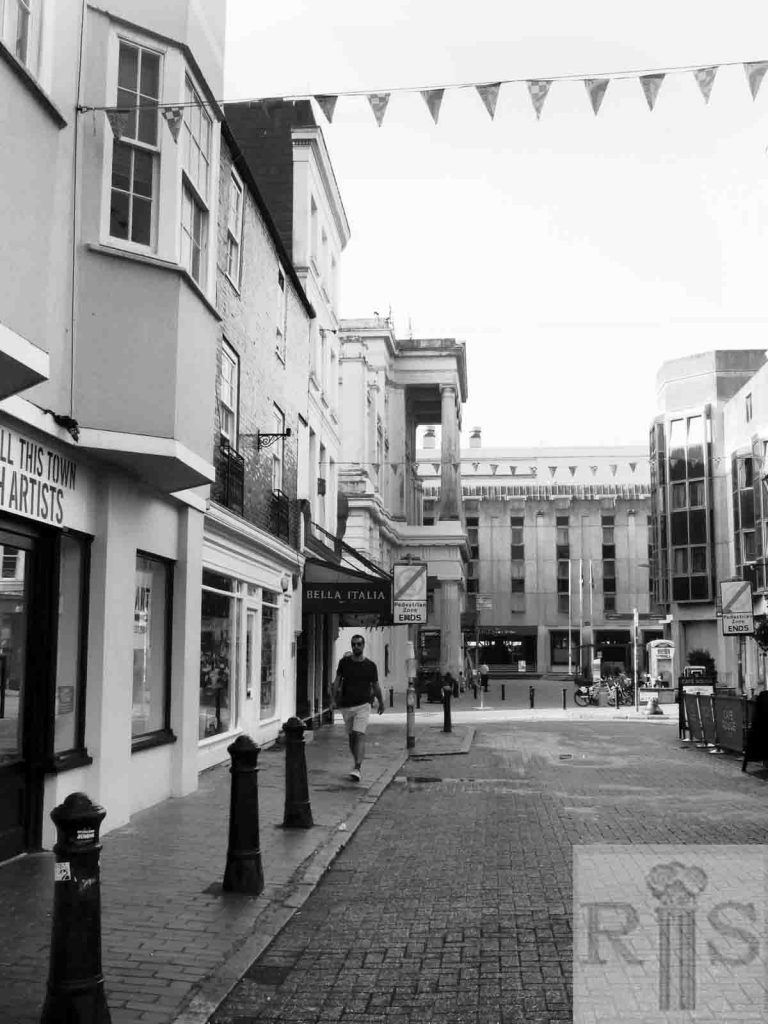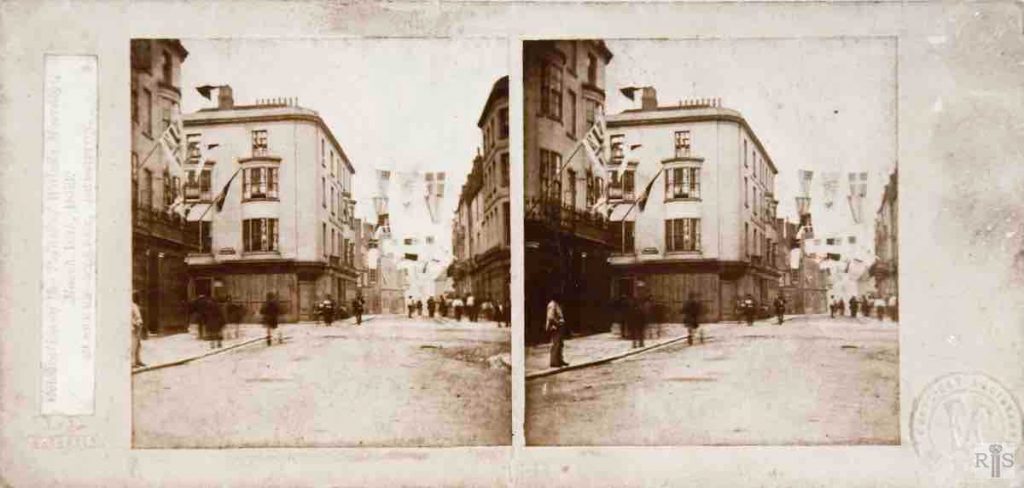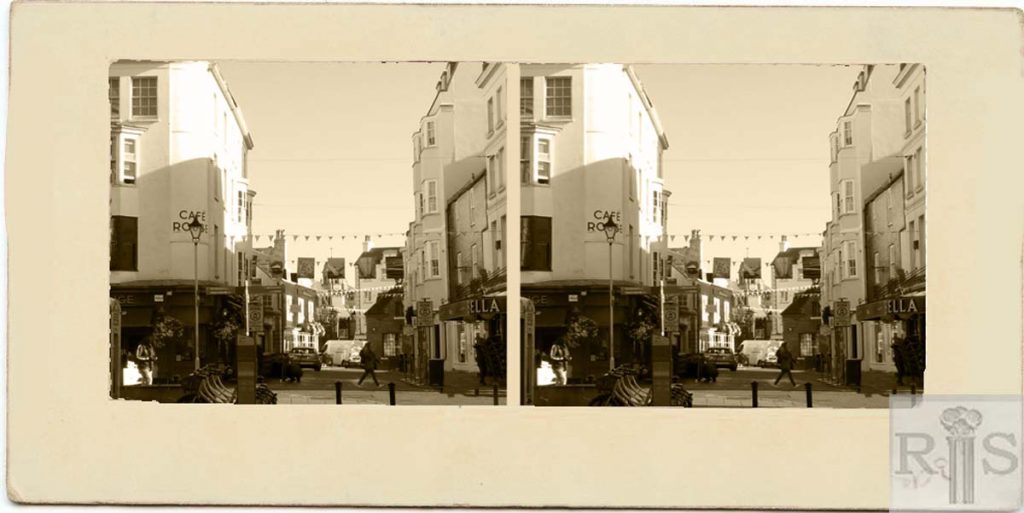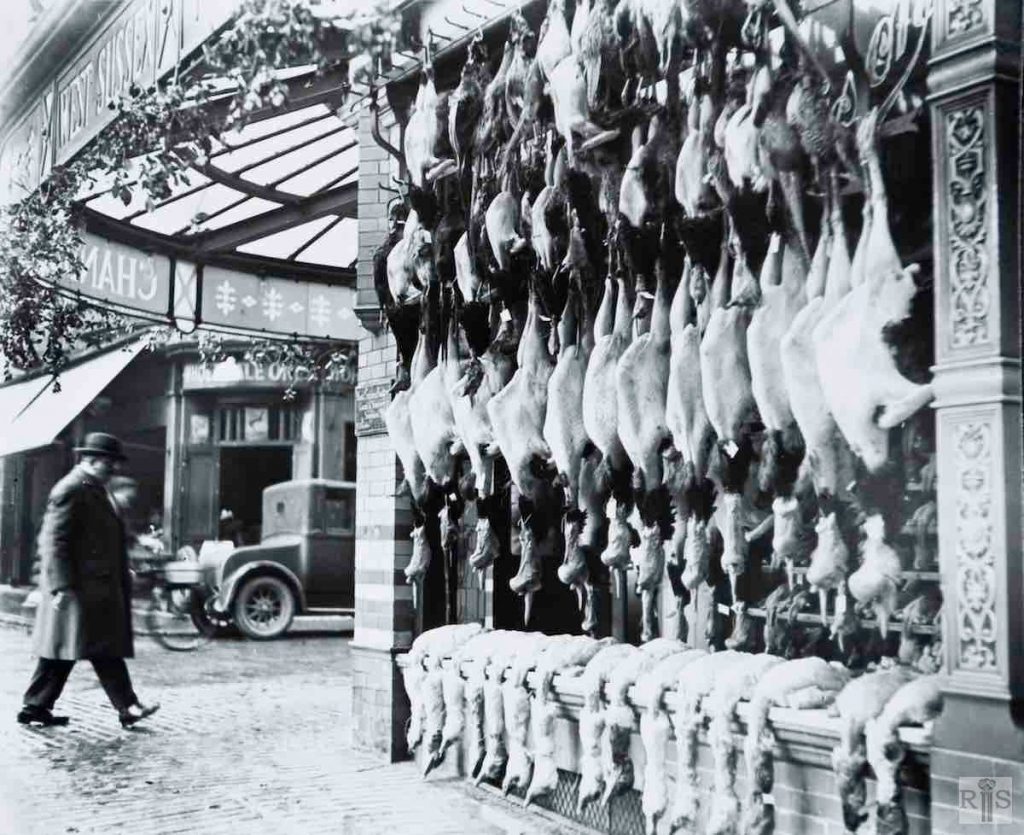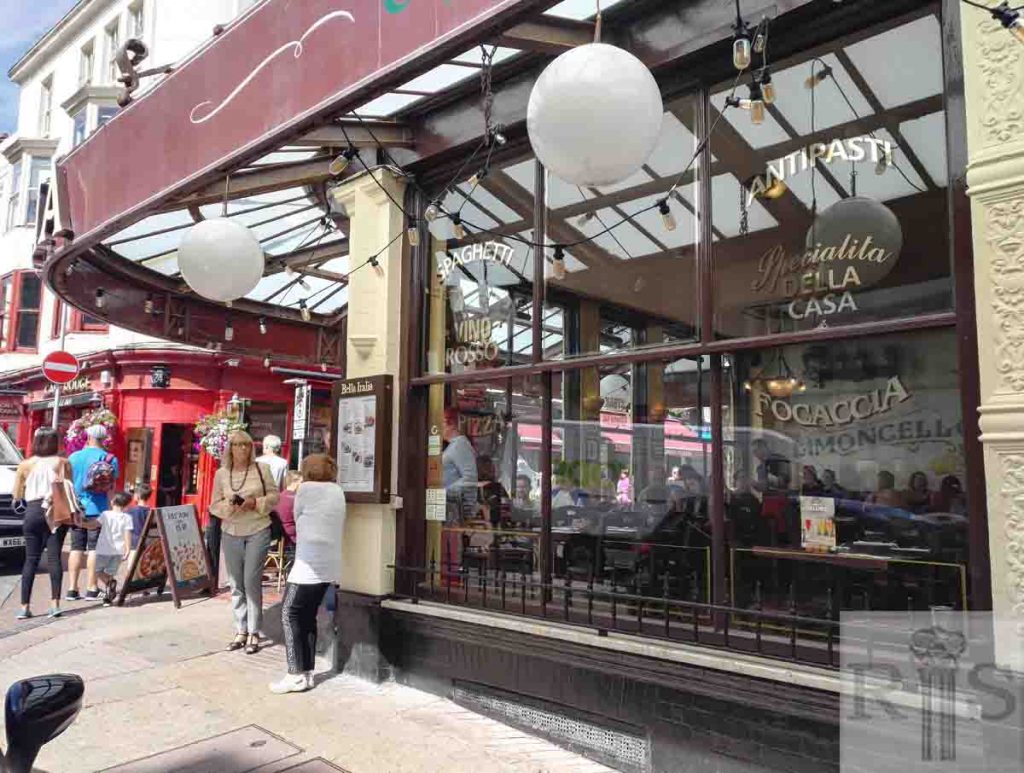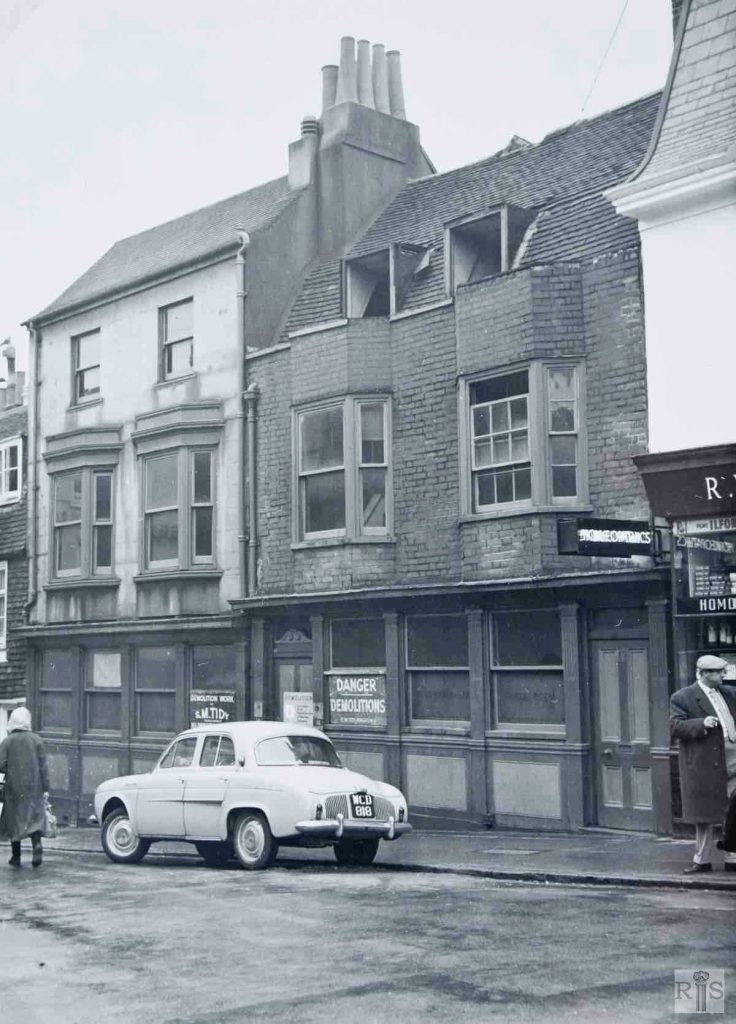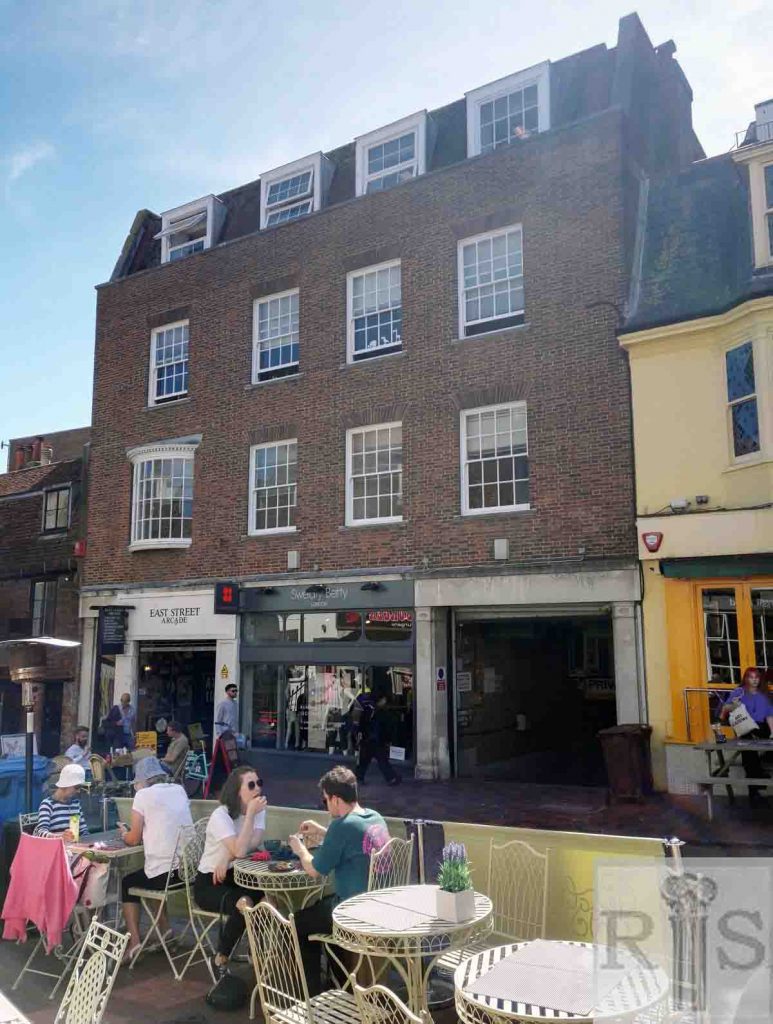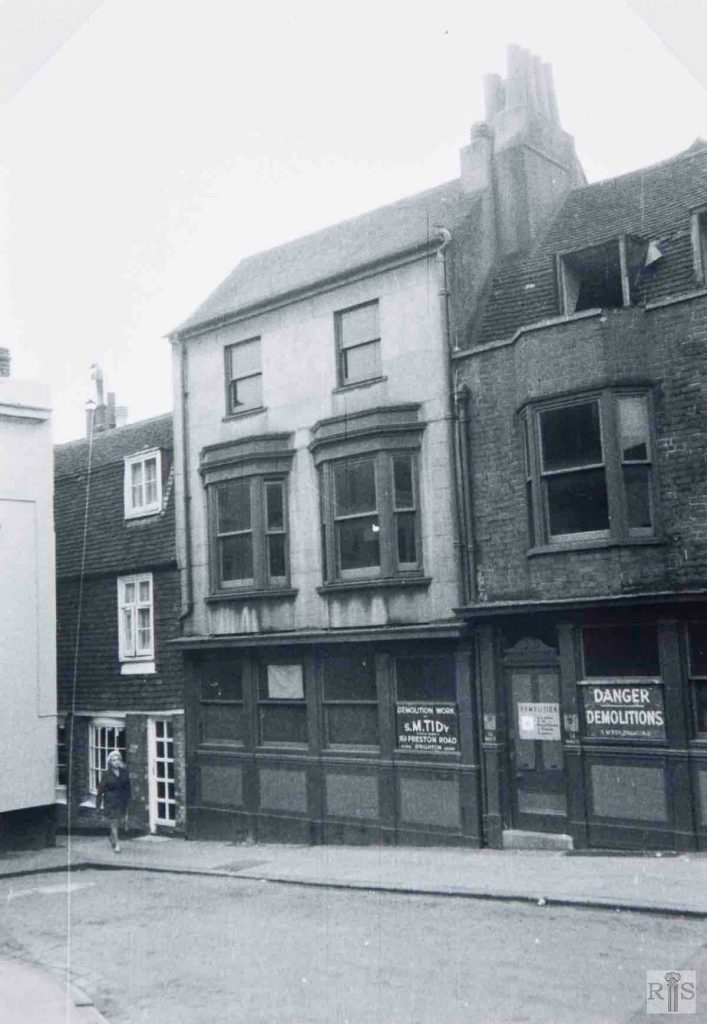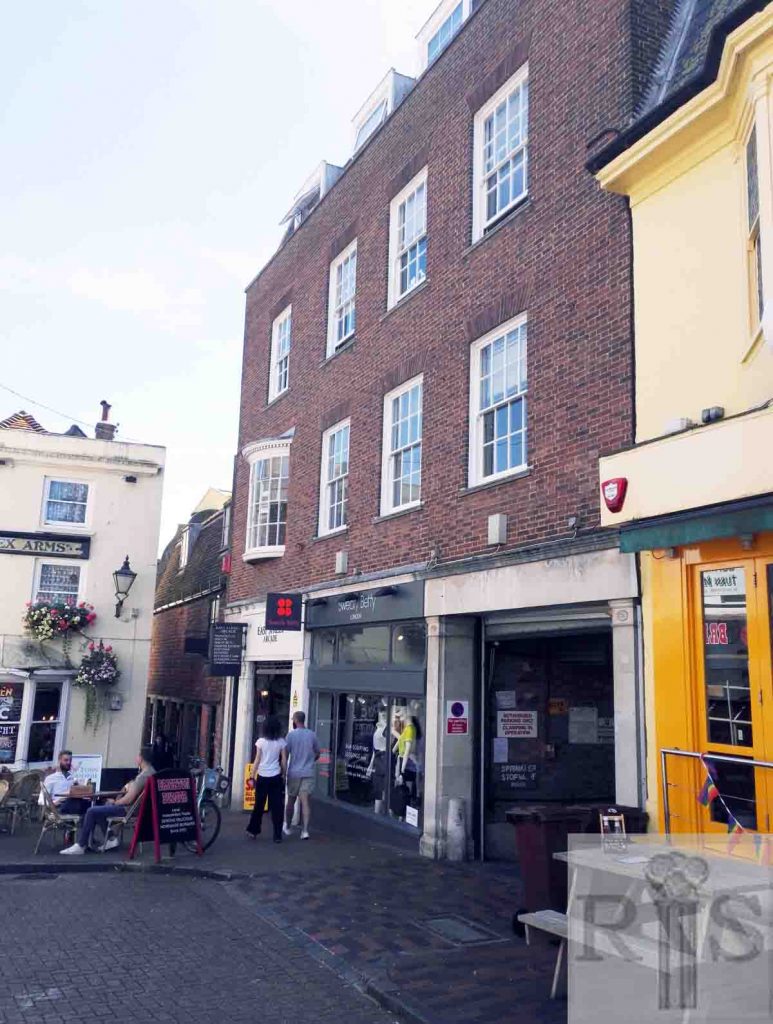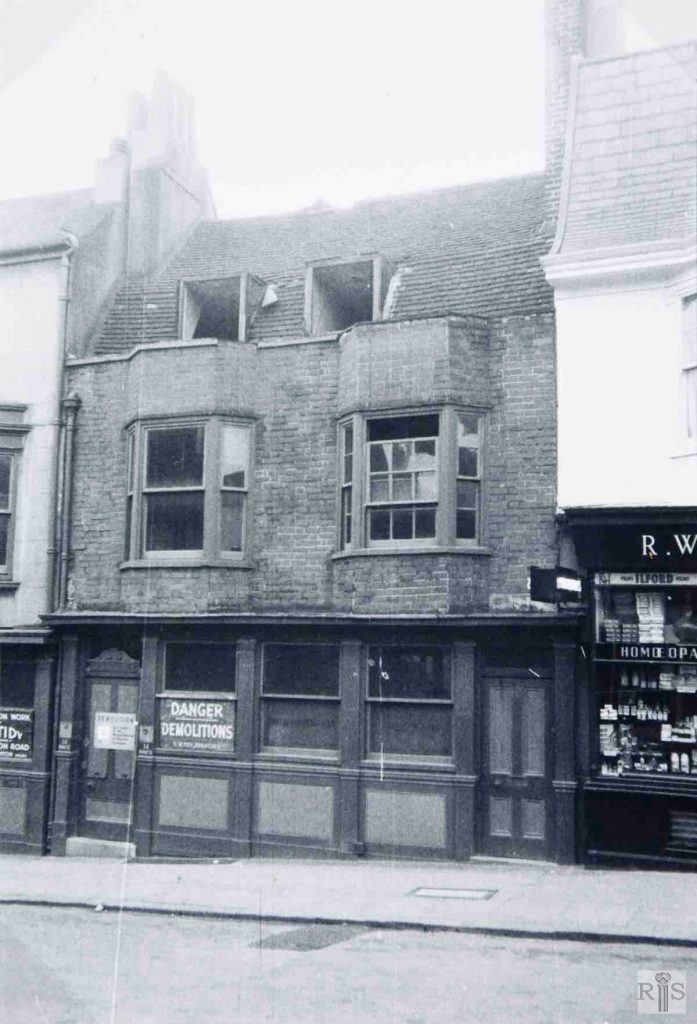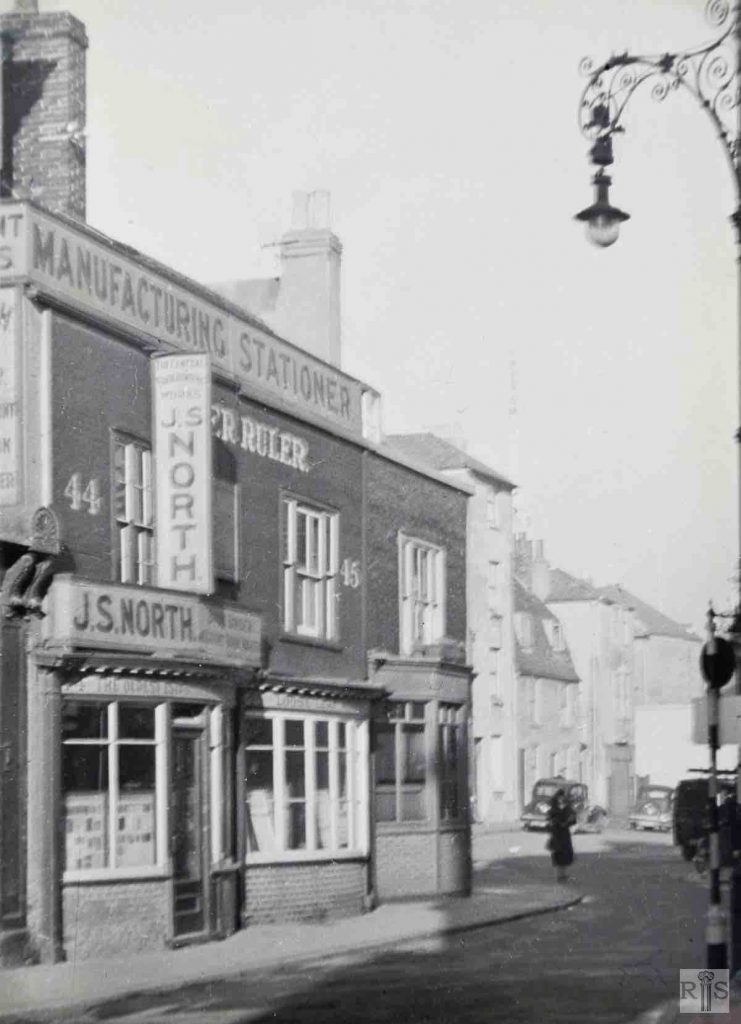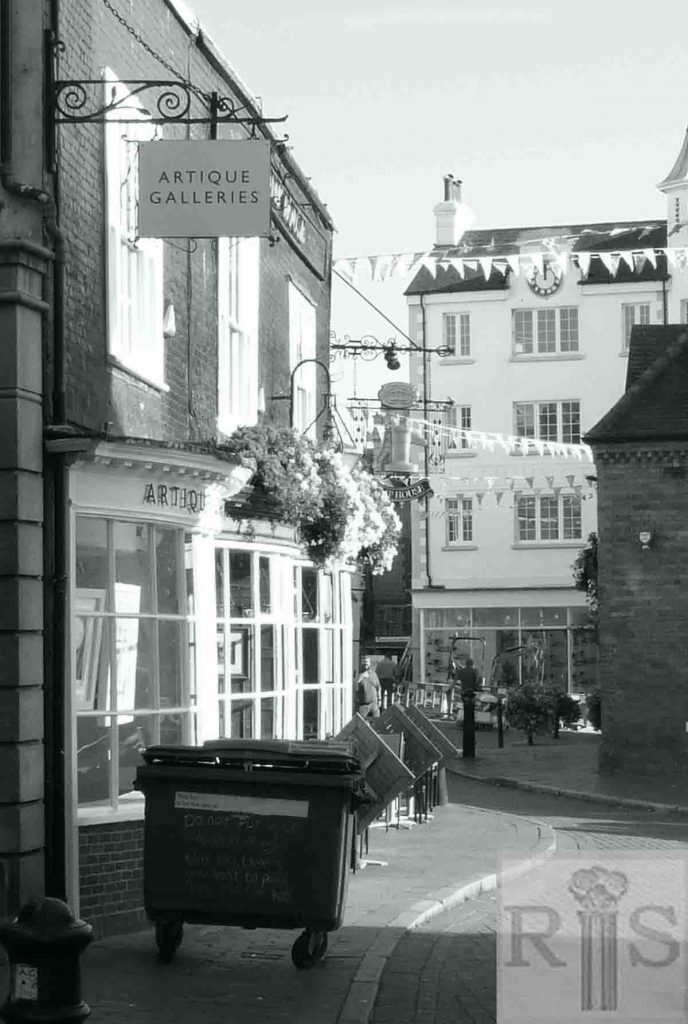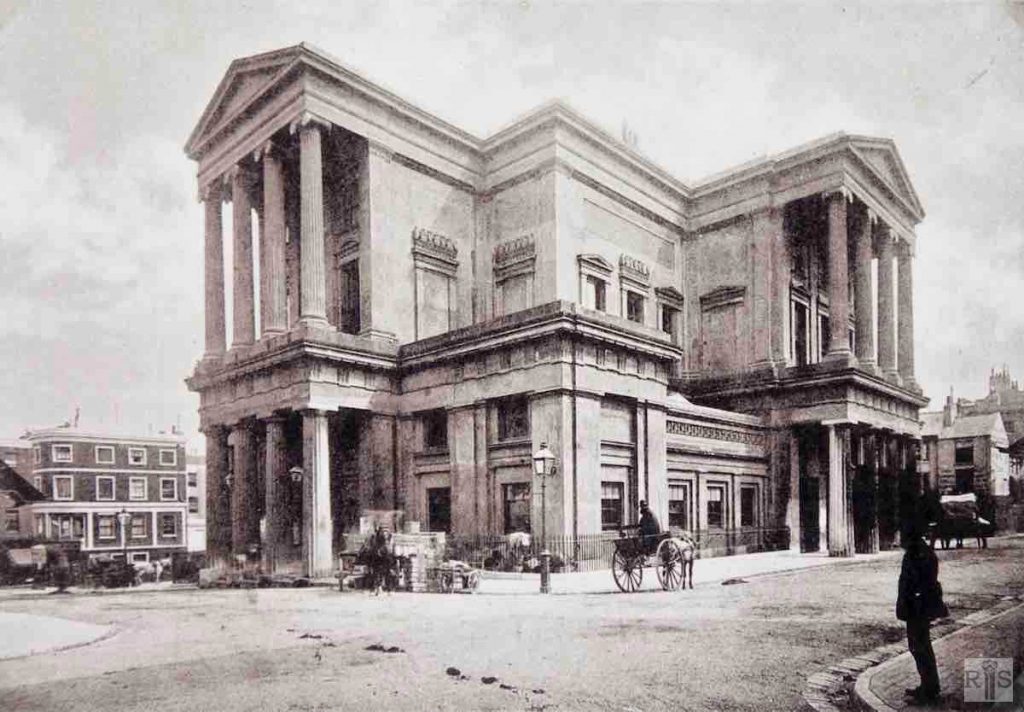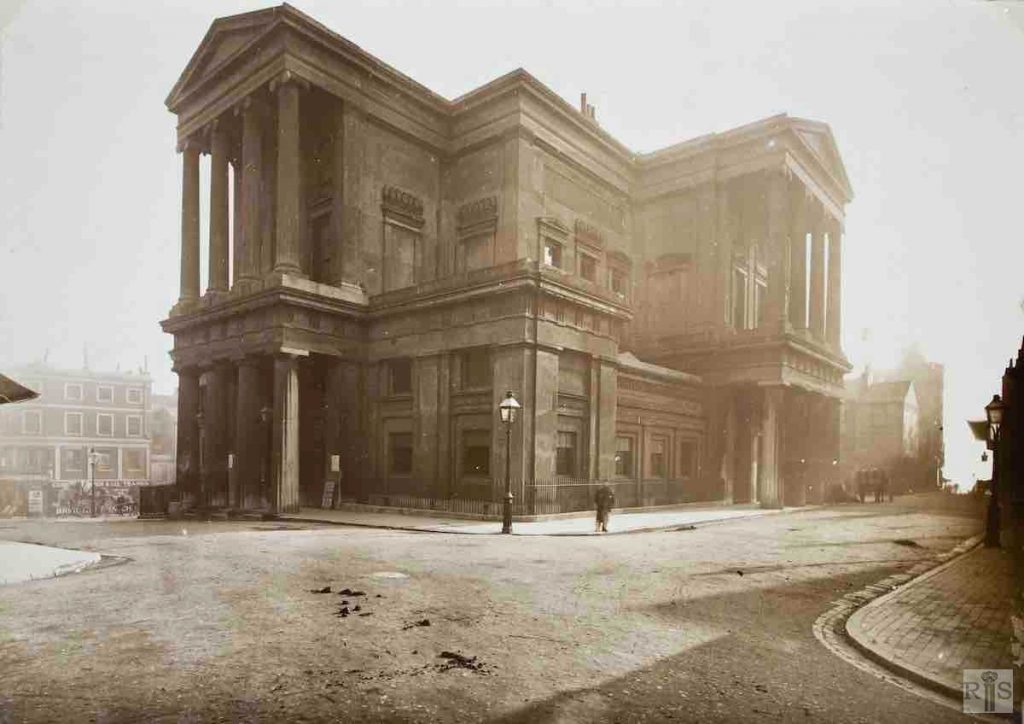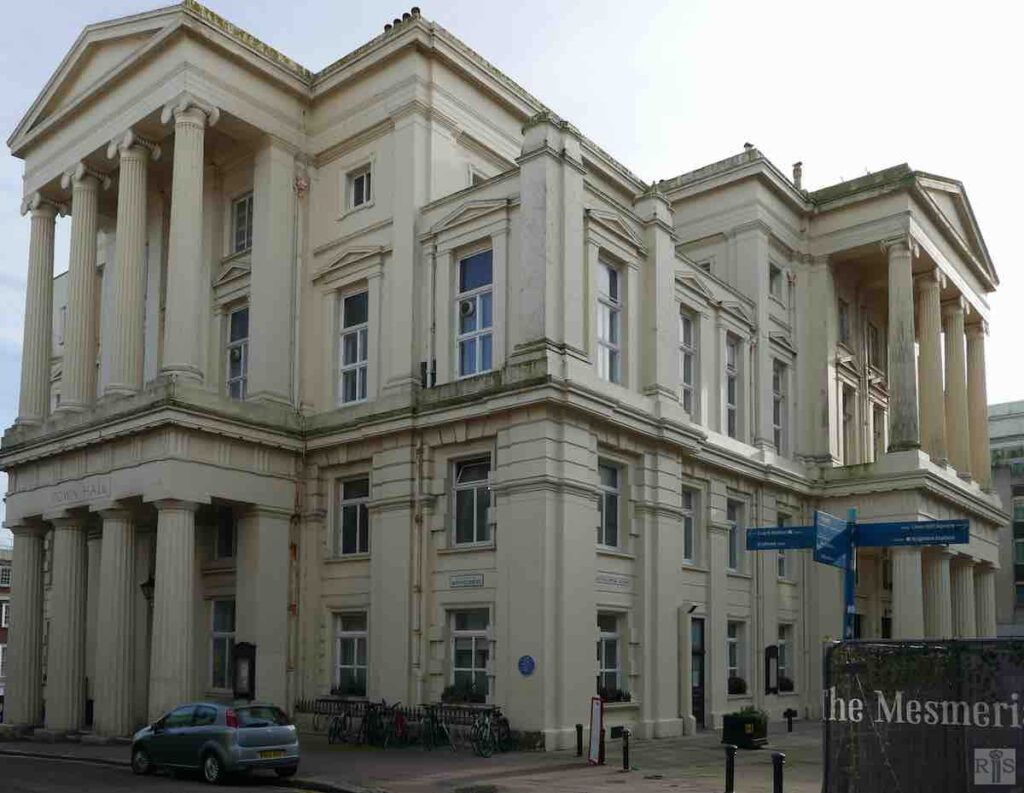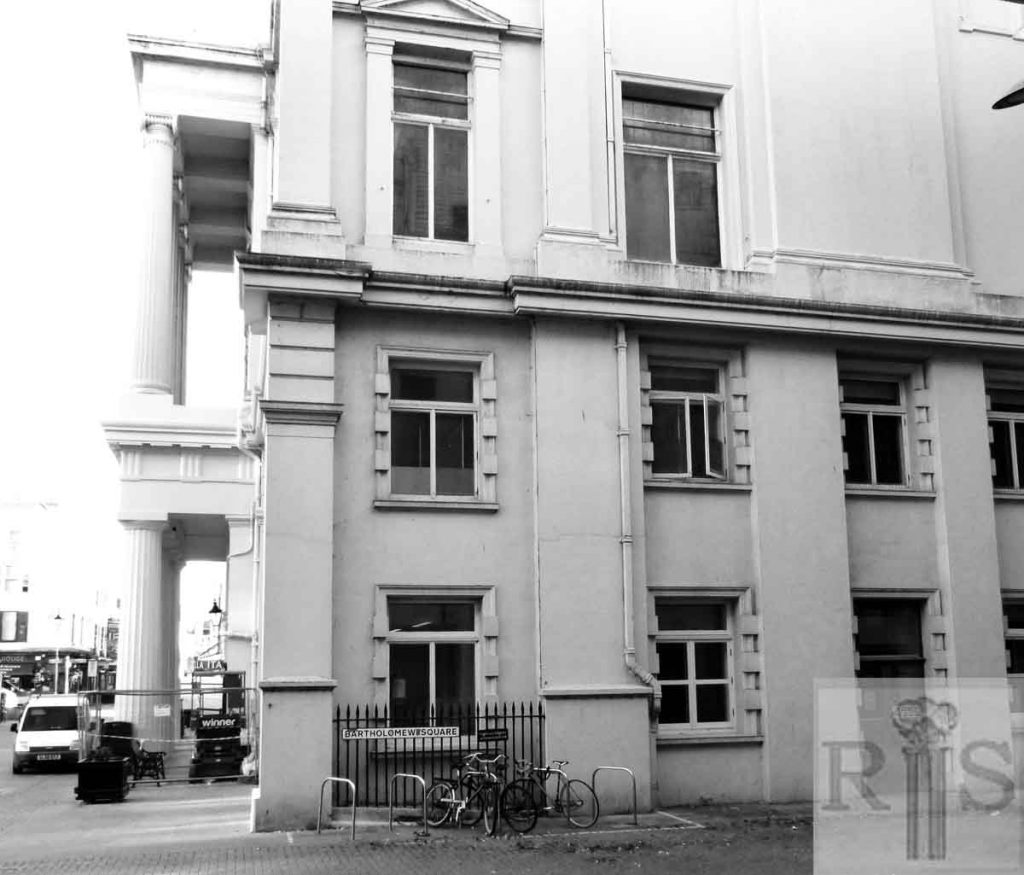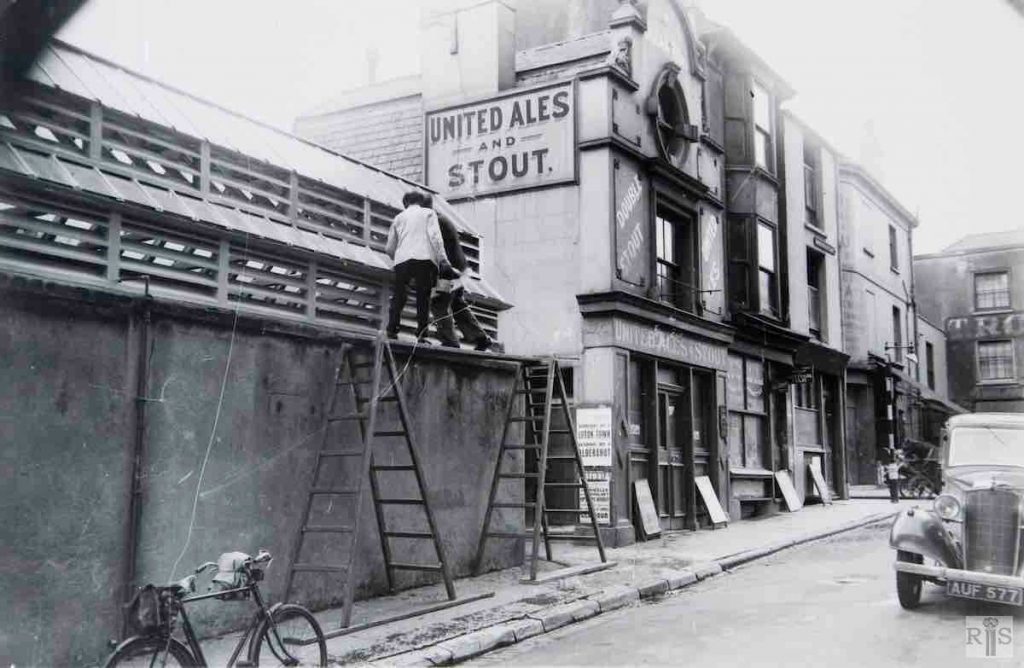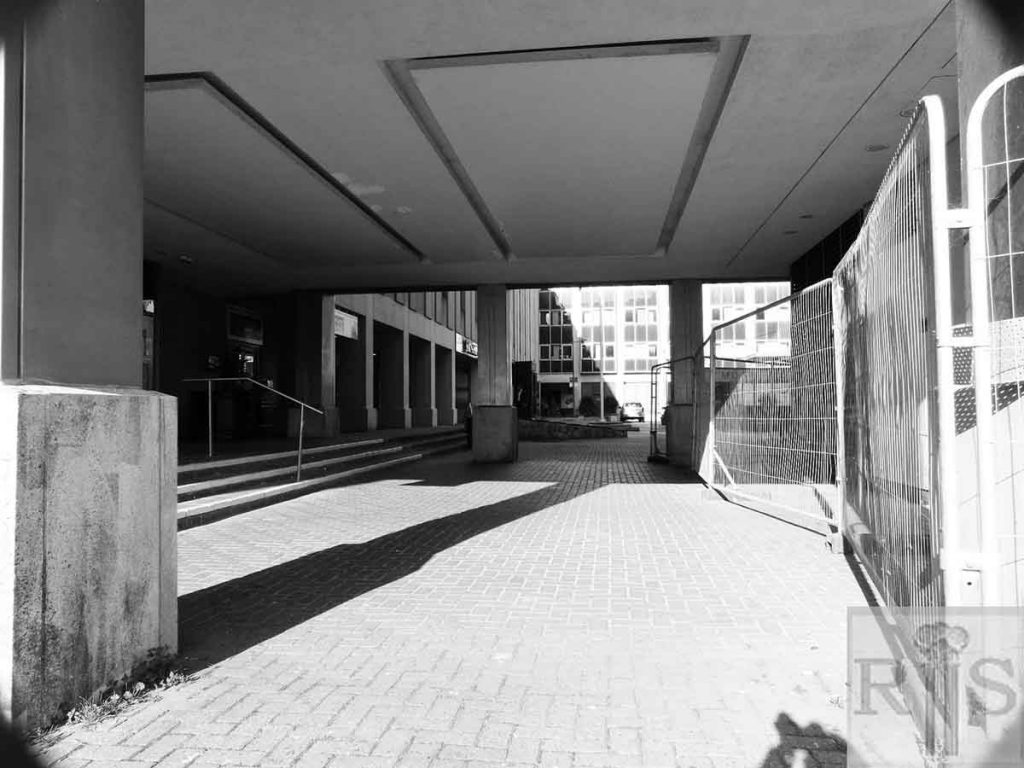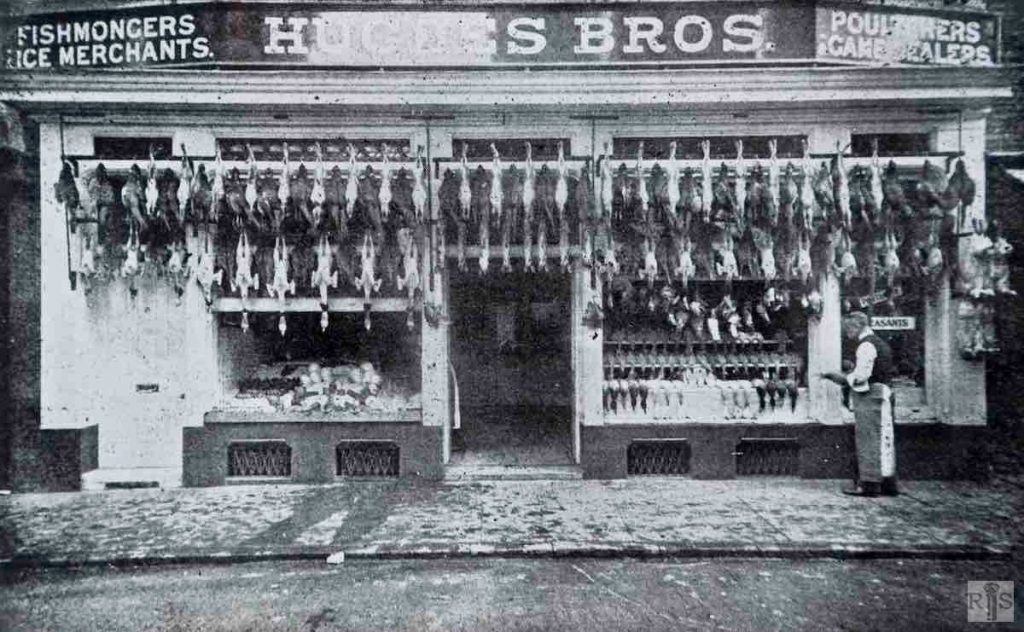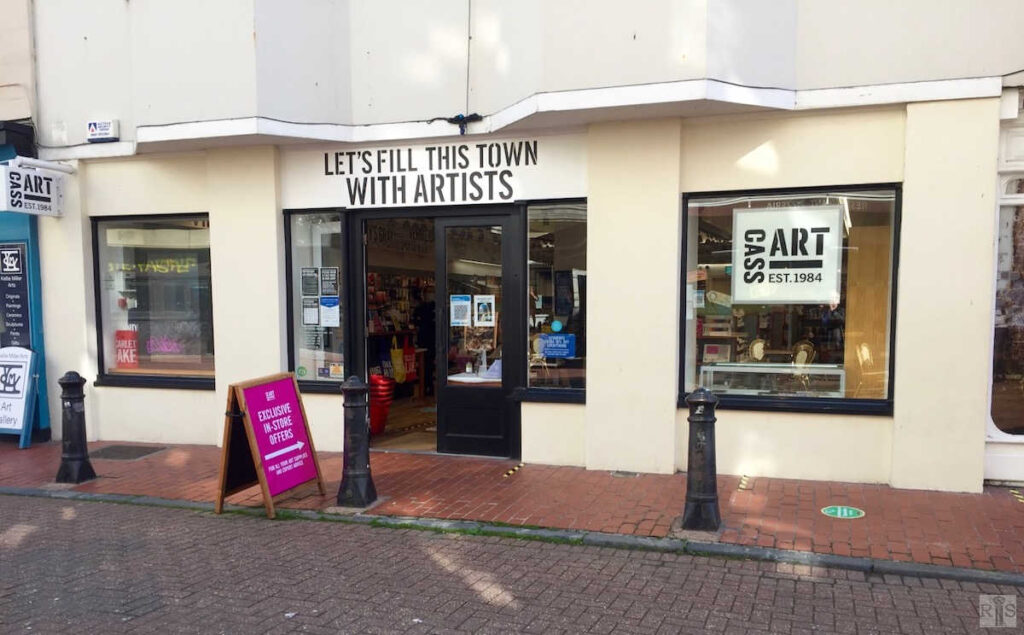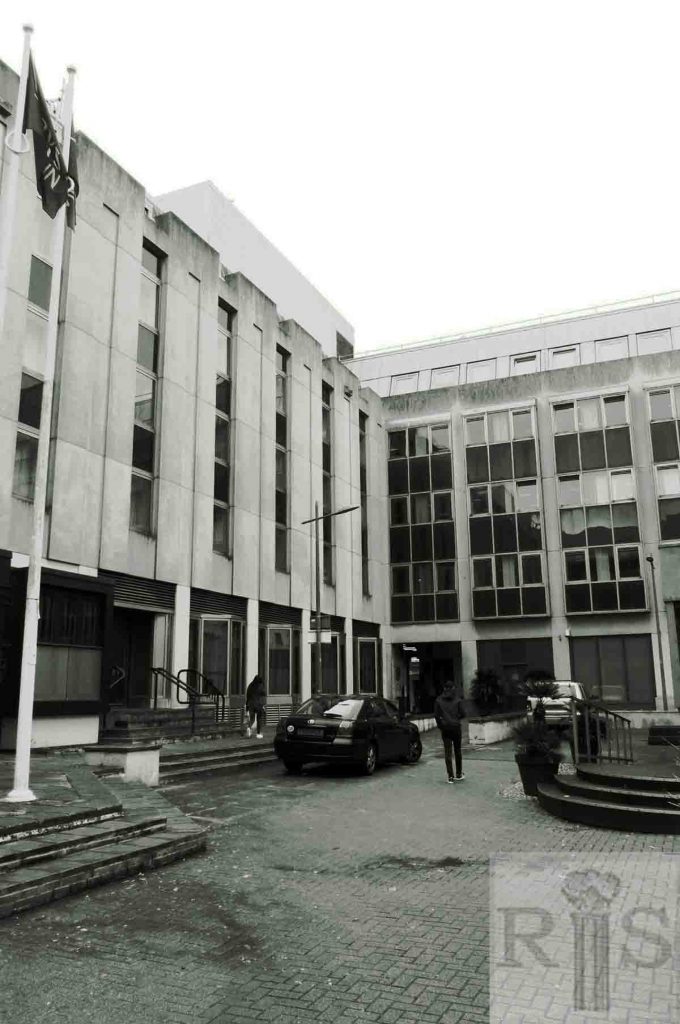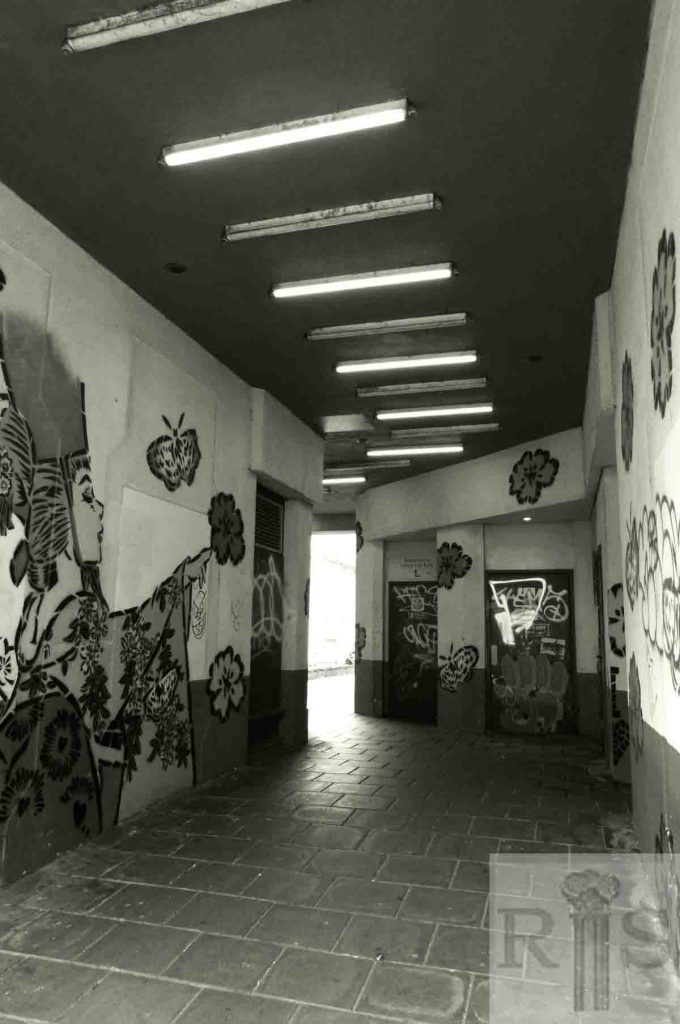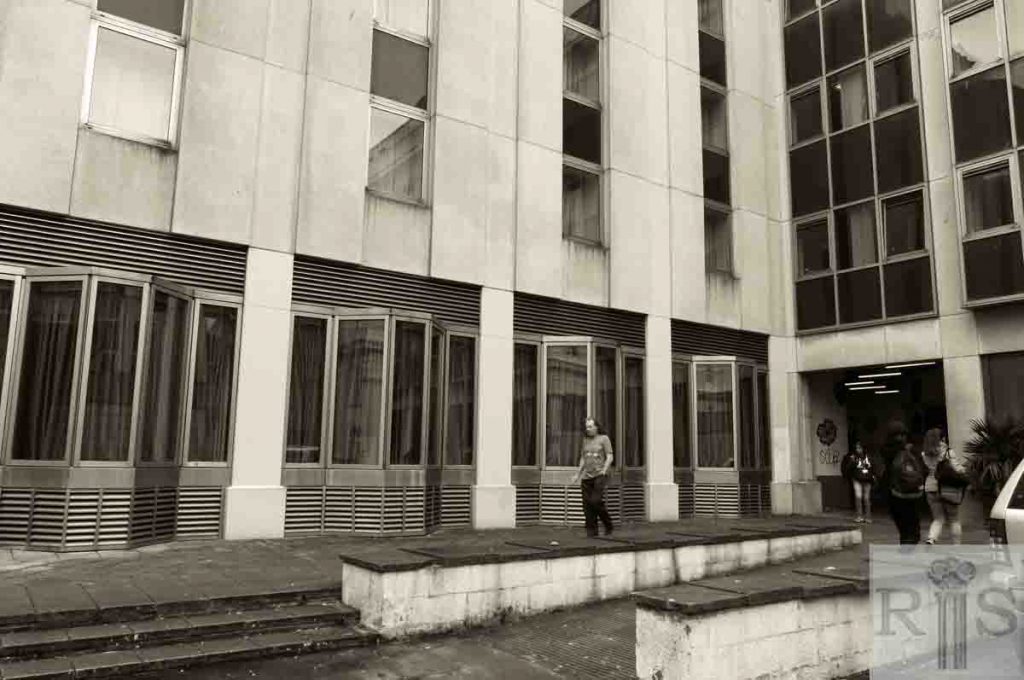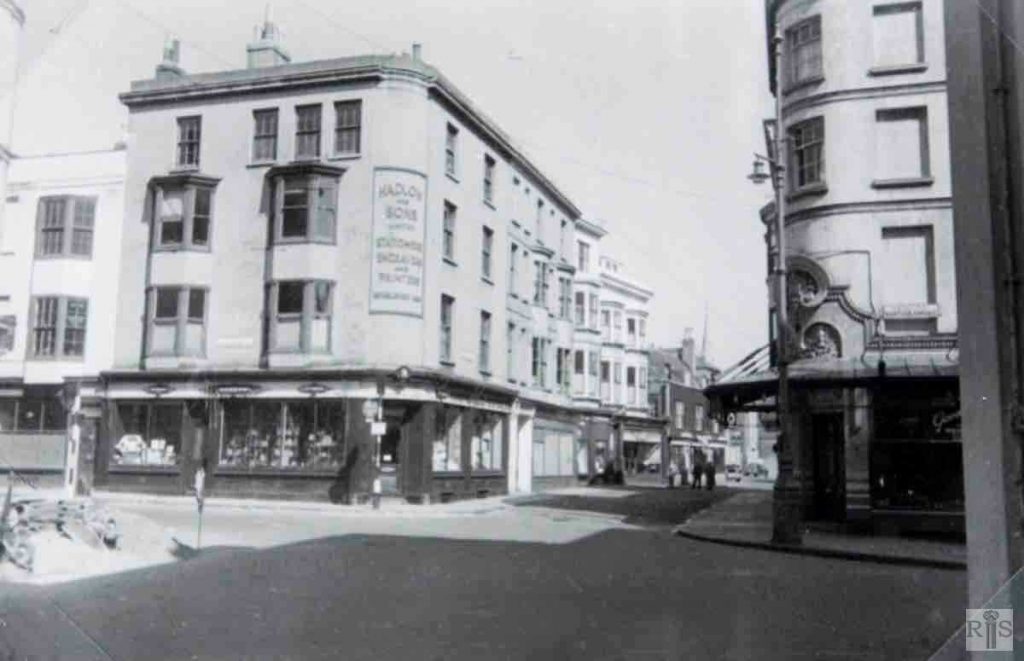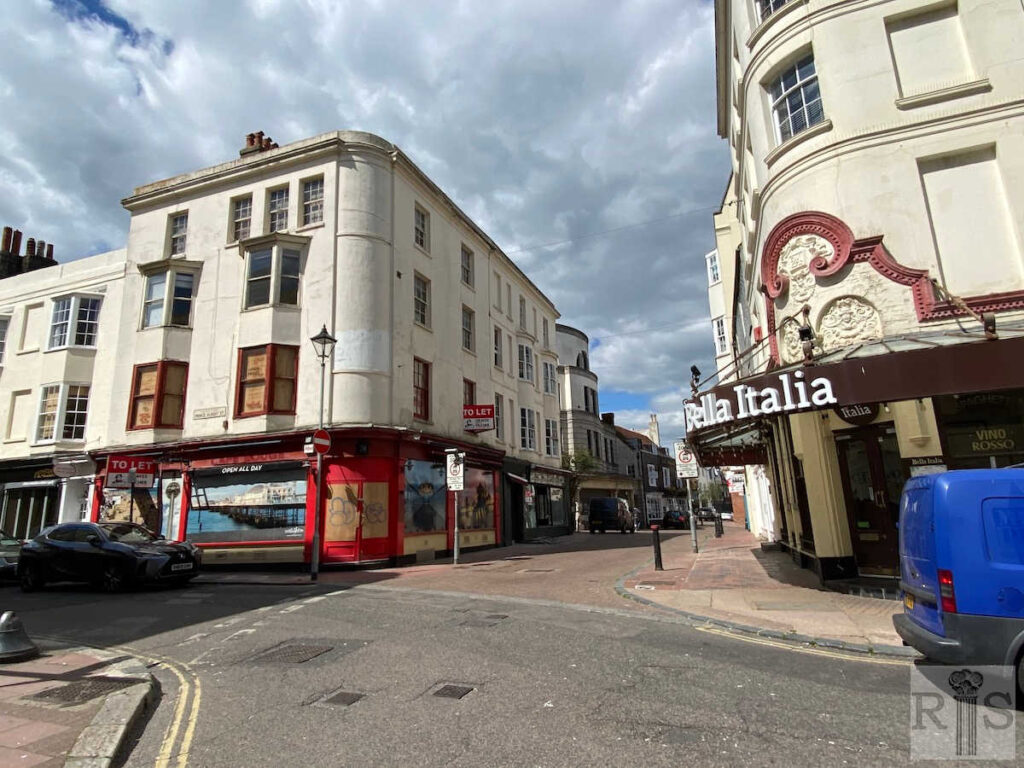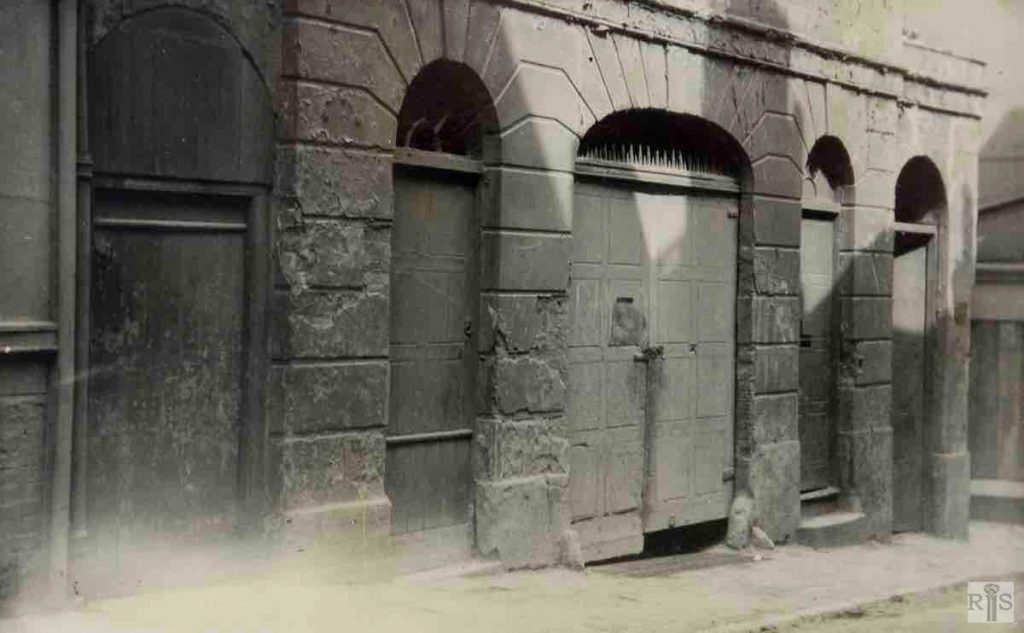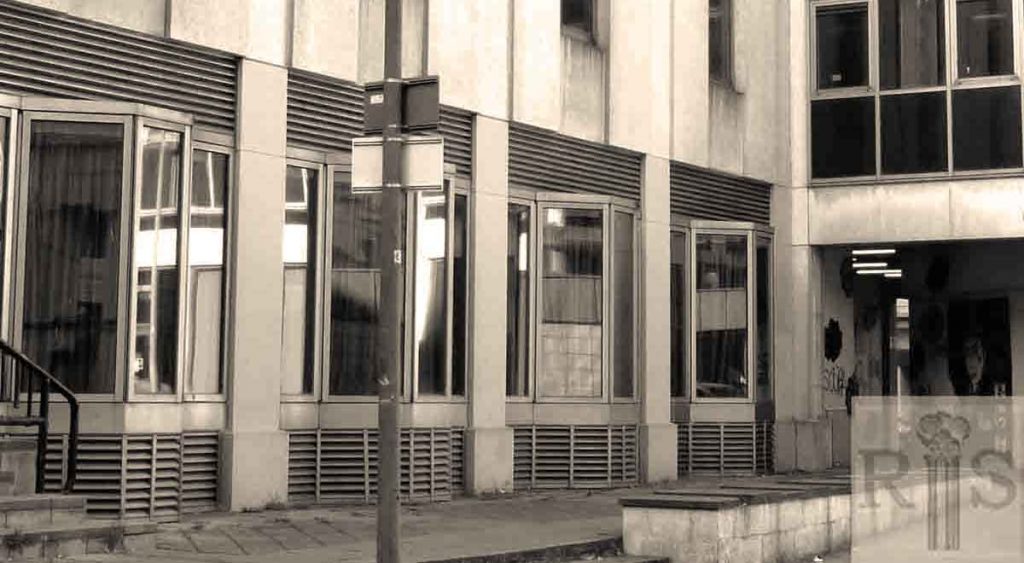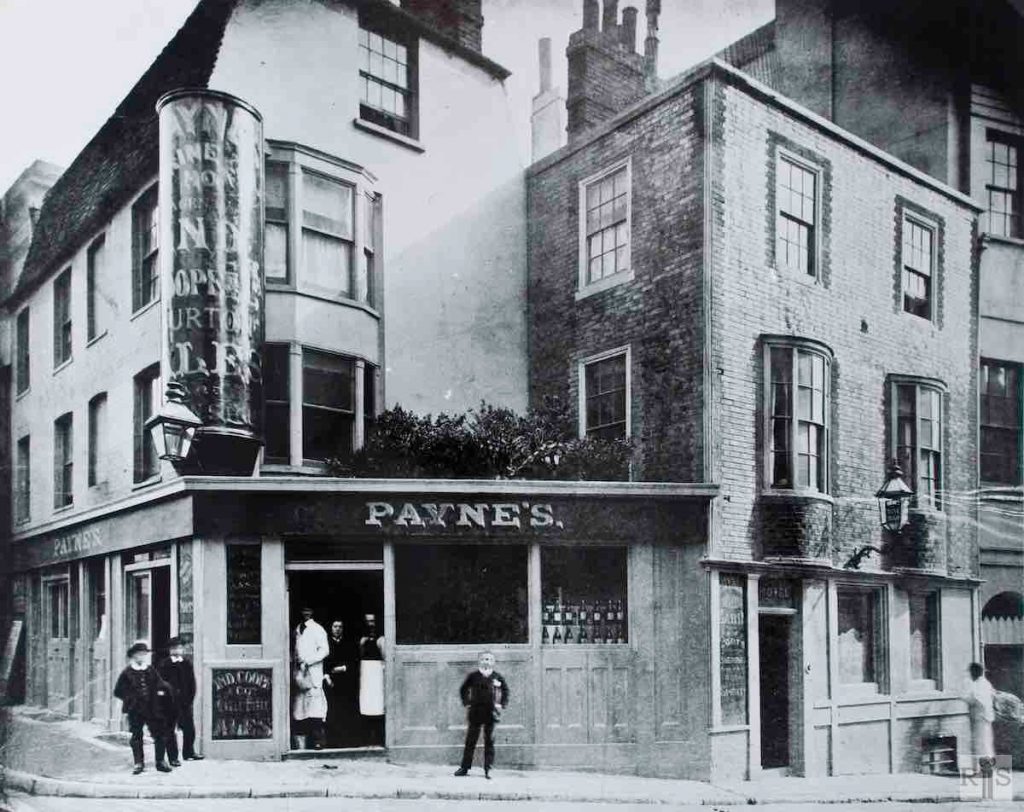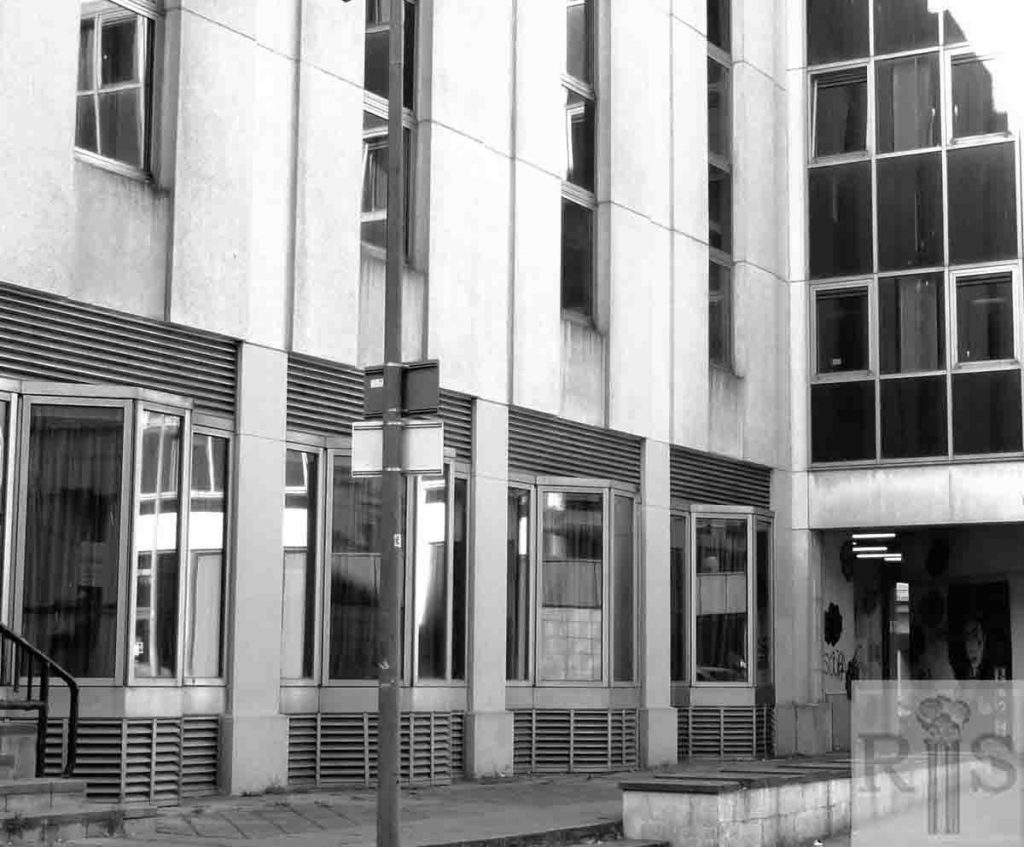
James Gray: The ironmongers shop of W. Slatter at 44 Market Street. Mr Slatter is standing in the doorway. Period unknown, but about 1900. It looks as if the adjoining premises were being used as a Town Hall annexe. Additional Information: In c.1845, this was the home of Edward Fox senior and his wife Sarah and five sons (Edward junior, being the photographer who took some of the photographs in these volumes). It is an attractive house with mathematical tiled front and bow windows, which today stands alongside The Pump House tavern. jgc_08_085
James Gray: A very fine photograph recently printed from an old wax paper negative, of the east side of Market Street about the year 1860. It is seldom that one can see a photograph of a Brighton business established in 1798, as was the baker’s shop of G. Lower, No 48 (left). At the other corner, screened by the blind, was the butcher’s shop of Richard Tuppen, while at 7, down the street, Cobb & Son were cork cutters. Additional Information: © Phillipe Garner. jgc_08_087
James Gray: The antique shop of Mr Burgess Hill in 1929. This was originally a double fronted private house with railings on both sides of the steps. Additional Information: Presumably, that is Mr Burgess standing in the shop doorway. jgc_08_088
2019: These pictures show No 10, which appears to have been a dry cleaner’s from about 1930 until the start of WW2 in 1939. It was a hairdresser’s after the war and is listed as such at least until the 1970s. It is now a jeweller’s called Number Ten. There seemed to have been lot of dry cleaners in the old town at one time, before washing machines and tumble dryers became widely affordable. (Photographer: Ron Fitton)
James Gray: This enlargement of the sepia original shows 43, Market Street, as it was in 1850. Then, as now, it stood at the corner of Nile Street. It was originally a private house, the doorway being that on the right. The stationers shop was an extension built over the forecourt of No 42, on the bow window with those of the present No 44. jgc_08_090
2019: Colliers did not survive long after the 1850s. No 43 was listed as being the home of Edward Fuller, a basket maker, in 1867 and William Burgess, an ironmonger, lived there in 1880.
James Gray: The same area a century later. In the late 1850s the business was taken over by T Waterfield and remained in his family’s control for many years until in 1896 it was acquired by Walter Gillett Ltd. At some time during the Waterfield era the old building was demolished and replaced by the present one, as can be seen in the photographs of Nile Street on another page. It is interesting to note that the premises have been in continuous occupation for more than 100 years. Additional Information: One of three on page. jgc_08_092
James Gray: A rather blurred and indistinct copy of a very early photograph of Market Street, looking south, with Brighton Town Hall at the left. The reason for the beflagged procession is not known but the photograph has the appearance of the ‘Sixties, so it might have had something to do with the wedding of the Prince of Wales (later King Edward V11th) in March 1863. jgc_08_093
2019: With the exception of the Town Hall itself, every building in the original photograph has been demolished and replaced. (Photographer: Ron Fitton)
James Gray: The quiet shuttered street on 10 March 1863, the Prince of Wales wedding day. Most of these buildings are little changed 100 years later. jgc_08_110
2019: A faux stereoscopic view of the same scene in 2019.
James Gray: A fine display of poultry in F. Chandler’s shop at 24 Market Street, at the corner of Bartholomews. He had this shop for so long that it is not possible to pinpoint the year of the photograph, but all signs point to the late 1930s. jgc_09_002
2019: The building and its distinctive canopy remain. The impressive display of game has been replaced by a Bella Italia restaurant at 24 Market Street.
James Gray: The creation of this arcade in the early 1960s involved demolition of premises occupied by probably the oldest established business in Brighton. Wallis, Holder & Lee had been in Market Street, lately at 14 and 15, since 1804 when the business was started by Mr Isaac Bass. They vacated these premises at Easter 1959, but it was a little later when the shop at the rear, 2 Bartholomews was acquired. These photographs [jgc_09_003 and 004] were taken on April 26th 1960 and the buildings were removed soon afterwards. The Arcade was opened in 1962. jgc_09_003
2019: The arcade was originally called Regent Arcade (see also jgc_09_005) and has been renamed East Street Arcade. It is a small shopping arcade which has two other entrances, in East Street and in Bartholomews. Wallis, Holder and Lee were wholesalers for groceries. (Photographer: Simon Cooper)
James Gray: Buildings removed for the later erection of Regent Arcade. 14-15 Market Street, occupied for many years by Wallis, Holder and Lee stand empty and in semi-dilapidation early in 1960 just a few months before their removal. jgc_09_005
2019: The buildings surrounding Regent Arcade, now East Street Arcade, have changed very little since the original image was taken. (Photographer: Simon Cooper)
James Gray: Buildings removed for the later erection of Regent Arcade. 14-15 Market Street, occupied for many years by Wallis, Holder and Lee stand empty and in semi-dilapidation early in 1960 just a few months before their removal. jgc_09_006
2019: The building has been replaced. The entrance to the East Street Arcade (formerly Regent Arcade) can be seen to the left of the picture. (Photographer: Simon Cooper)
James Gray: Buildings removed for the later erection of Regent Arcade. 14-15 Market Street, occupied for many years by Wallis, Holder and Lee stand empty and in semi-dilapidation early in 1960 just a few months before their removal. jgc_09_007
2019: The view is still recognisable, but only just. The transformation from run-down street to busy tourist hub is remarkable. (Photographer: Simon Cooper)
James Gray: View of Brighton Place, from Market Street taken on 19 January 1937. The old houses 44-45 Market Street, for so long occupied by the late Mr. J S North, have now been converted for use as the Regency Coffee House. jgc_09_045
2019: Currently an art gallery, No 44 Market Street remained as a coffee shop well into the 1970s. Here is a view looking north from outside No 44 up to Brighton Place. It is noticeable how much more cluttered the pavements are now compared to those in the original photograph – scarcely room to walk in some places! It is interesting to note that even earlier than in the original photo, the pioneer photographer Edward Fox (1823-1899) lived at 44 Market Street and was taking photographic views of Brighton as early as 1851, many of which appear in the James Gray Collection. (Photographer: Ron Fitton)
James Gray: The foundation stone of the Town Hall was laid in 1830. Enlargement and remodelling became necessary, so the upper part of the [east] frontage was built out over the heavy balcony. At the same time the Police Station was established where the large flight of steps fronted Little East Street. [See jgc_09_051 on the Bartholomews page.] The Town Hall was reopened in its present form in 1899. jgc_09_050
James Gray: Brighton Town Hall and Market Street in 1882. jgc_09_052
2020: Both jgc_09_050 and 052 are views of the north and west fronts of the Town Hall. This is the view from the corner of Prince Albert Street today. Market Street (to the right of the picture) originally continued all the way past the west façade down to the seafront. (Photographer: Jayne Paulin)
James Gray: Looking north along Market Street, with the Town Hall on the right. Old houses in Little East Street had recently been removed and the cleared space used as a car park. No 10 Bartholomews was used as the Town Hall Annexe, which was connected with the main building by a bridge crossing the street. jgc_09_053
2019: Bartholomew Square stands on the site of the southern part of Market Street today, facing the western portico of the Town Hall. Gray’s image shows the southern wing of the building in the foreground, which was never fully completed. (Photographer: Ron Fitton)
James Gray: South side of Bartholomews looking west to Market Street. These old houses 11-13 were demolished soon afterwards. Two were occupied as Public Houses, the Ocean Wave and the Fishmongers Hall, the side wall of which can be seen in [jgc_09_053] the previous photograph. jgc_09_054
2019: The south side of Bartholomew Square looking west towards where Market Street was once located.
James Gray: Another poulterer’s shop, this time at 21-22 Market Street, in 1907. Starting here as M & R Hughes in 1845 the business finished as Staples, Hughes and Hudson in 1936. So for 91 years this poultry business continued in an area long denuded of its resident population. The Nanking Chinese Restaurant was opened on these premises after the 1939-1945 War. jgc_09_075
James Gray: After the clearance of the Little East Street buildings, seen on a previous page, the next to go were 27 and 28 Market Street, at the extreme southern end on the east side. They are seen here under demolition. jgc_09_076
2019: The Jury’s Inn Waterfront Hotel now stands here. The southern part of Market Street has completely disappeared. (Photographer: Ron Fitton)
James Gray: After the clearance of the Little East Street buildings, seen on a previous page, the next to go were 27 and 28 Market Street, at the extreme southern end on the east side. They are seen here under demolition. jgc_09_077
2019: The passageway in the corner of the Jurys Inn Waterfront Hotel leads to Black Lion Street today. (Photographer: Ron Fitton)
James Gray: After the clearance of the Little East Street buildings, seen on a previous page, the next to go were 27 and 28 Market Street, at the extreme southern end on the east side. They are seen here under demolition. jgc_09_079
2019: See jgc_09_077 for a previous stage of the same demolition. The centre of the façade of Jurys Inn Waterfront Hotel now stands where these houses stood. (Photographer: Ron Fitton)
James Gray: Junction of Prince Albert Street, Market Street and Bartholomew’s, also about 1950. Hadlows, the Printers, Stationers & Engravers had occupied the corner premises since the 1850s. jgc_08_083
2020: The same junction of streets seventy years later is still totally recognisable. Notice in particular the plasterwork above the entrance to the porch of the Bella Italia restaurant and the awning along its Market Street side, both of which can be seen in the 1950 image.
James Gray: Old commercial buildings in Little East Street, which adjoined the Marine Hotel [see jgc_09_058 below] in Market Street. Date of photograph – August 1930. Removed with other buildings in 1934. It took me years to locate where these buildings were, and it was only the Marine Hotel picture that solved the mystery. jgc_09_096
James Gray: This photograph, probably of the 1880s, gives an all-round view of this small, but popular hotel, in the heart of the old town. It stood at the corner of Market Street (left) and Little East Street (right). I do not know when the building was erected, but by the 1850s it was the Marine Tavern. It remained as an hotel until the First World War, and then used for other business purposes. Demolished in 1934, its site has since been used as a car park. Note the elegant black mathematical tiled façade of the Little East Street frontage. jgc_09_058
